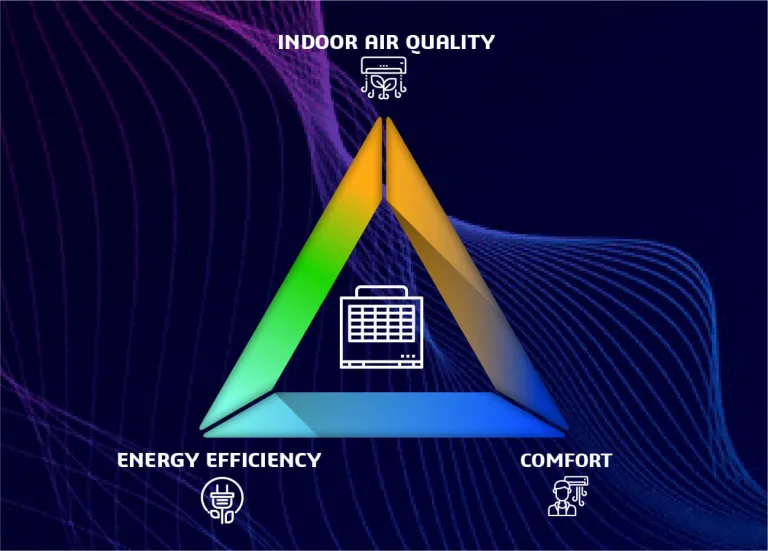Decarbonize Building Operations With an Optimized HVAC System
Utilize simulation and virtual twin technology to create optimal HVAC systems and reduce building emissions from end to end.
Understanding HVAC Systems for Energy Optimization and Decarbonization
HVAC (Heating, Ventilation, and Air Conditioning) systems are key to reducing energy consumption and carbon emissions in buildings. By optimizing heating, cooling, and ventilation processes, modern HVAC systems can significantly improve energy efficiency. Utilizing advanced technologies like simulation and virtual twin models, these systems help identify inefficiencies, lower operational costs, and contribute to the decarbonization of building operations, making them crucial for sustainability efforts.
Fight Global Warming With Indoor Climate
Heating, ventilation and air conditioning (HVAC) in buildings is one of the largest contributors to global carbon emissions. HVAC systems are currently responsible for 20%1 of building electricity consumption worldwide and 10%2 of all global electricity consumption.
As such, HVAC performance cannot be an afterthought but must be integrated into every stage of HVAC system design to lower its end-to-end carbon footprint. And HVAC optimization is possible by utilizing virtual twin technology for HVAC simulation.
Simulate HVAC Systems for Green-Building
Read our ebook and discover how to optimize your HVAC system to improve energy efficiency, air quality and comfort in buildings.
Government Regulations and Standards for HVAC Systems
Compliance with Energy and Building Codes
HVAC systems must meet local building codes and energy efficiency standards to ensure optimal performance and environmental responsibility. Key standards include ASHRAE 90.1 in the U.S. and the Energy Performance of Buildings Directive (EPBD) in the EU.
Sustainability Certifications
HVAC systems are often designed to meet sustainability certifications like LEED and BREEAM, which set benchmarks for energy efficiency and carbon reduction in building operations.
Supporting Decarbonization Goals
By adhering to these regulations, HVAC systems can significantly reduce energy consumption, lower carbon emissions, and contribute to global sustainability efforts.
Balance Energy Efficiency, Indoor Air Quality and Comfort
A holistic approach is needed to overcome the challenges of building and sustaining green buildings. While demand for energy efficiency has become more stringent, indoor air quality and comfort cannot be compromised. Instead, these three competing factors need to be optimally balanced.
To deliver HVAC systems with a lower carbon footprint while preserving comfort and air quality, manufacturers can leverage 3D modeling and simulation technologies for insights into HVAC performance. For example, simulation can be used to predict the emission, propagation and deposition of particles across the built environment versus the impact they have on the safety of building occupants.
Backed by virtual twin technology, simulation can accelerate cost-effective, sustainable HVAC innovation. For instance, simulation of a building’s virtual twin enables engineers to quickly spot and rectify causes of inefficient heating including:
Weather effects
Existing or potential sources of heat loss
Inaccessible locations for the HVAC system
Advancements in Adaptive Building Design
“By leveraging newer technologies and adaptive building designs, recent studies estimate that cooling and heating energy consumption intensity could decrease by 23%3 and 75%4 respectively.”
With simulation, HVAC components and systems can be designed and optimized much earlier in tandem with the rest of the building without compromising safety and security. Engineers and architects can improve the system’s integration in building operations from the onset to:
Reduce operating costs
Maximize occupant comfort
Ensure indoor air quality compliance
Benefits of Optimized HVAC Systems
One for All Climate System Platform
As a collaborative hub, the 3DEXPERIENCE® platform brings together systems engineering, modeling, simulation and project management solutions to streamline all HVAC system processes and support innovative collaboration on a single integrated cloud-based platform.
"We can use the 3DEXPERIENCE platform to educate and communicate how the building performs," shared Charles Luzzato, SIMULIA Global Industrial Equipment Industry Process Expert at Dassault Systèmes.
Through the platform, the entire HVAC ecosystem can utilize simulation for year-round performance verification to ensure that HVAC systems operate efficiently, even in the hottest summer and coldest winter.
Backed by data-driven insights from multiscale simulations on the 3DEXPERIENCE platform, the carbon footprint of HVAC systems can be reduced from cradle to cradle. And this will go a long way to cutting carbon emissions from the built environment by 2040 to meet the 1.5° climate targets.
Gain an Edge in HVAC System Design
Create the optimal HVAC system with virtual twin technology and simulation on the 3DEXPERIENCE platform.
Dassault Systèmes' in-house expert, Charles Luzzato, shares how you can maximize the potential of simulation.
FAQ About Heating, Ventilation, and Air Conditioning System & Technology
Related Content
Decarbonization
Decarbonization aims at reducing emissions throughout the product and service’s life cycle and across the full value chain.
Power and Fluidic Equipment
New technologies have transformed how power and fluidic equipment is designed by providing increased flexibility, accuracy, analytics and customization capabilities.
Fluid Engineering
Design End-to-end, compliant Fluid Systems in a Collaborative Product Development platform.
Decarbonizing Industry Operations
Through digital transformation, industries can rethink their operations, from product design to supply chains, and move toward more sustainable, resource-efficient processes.


